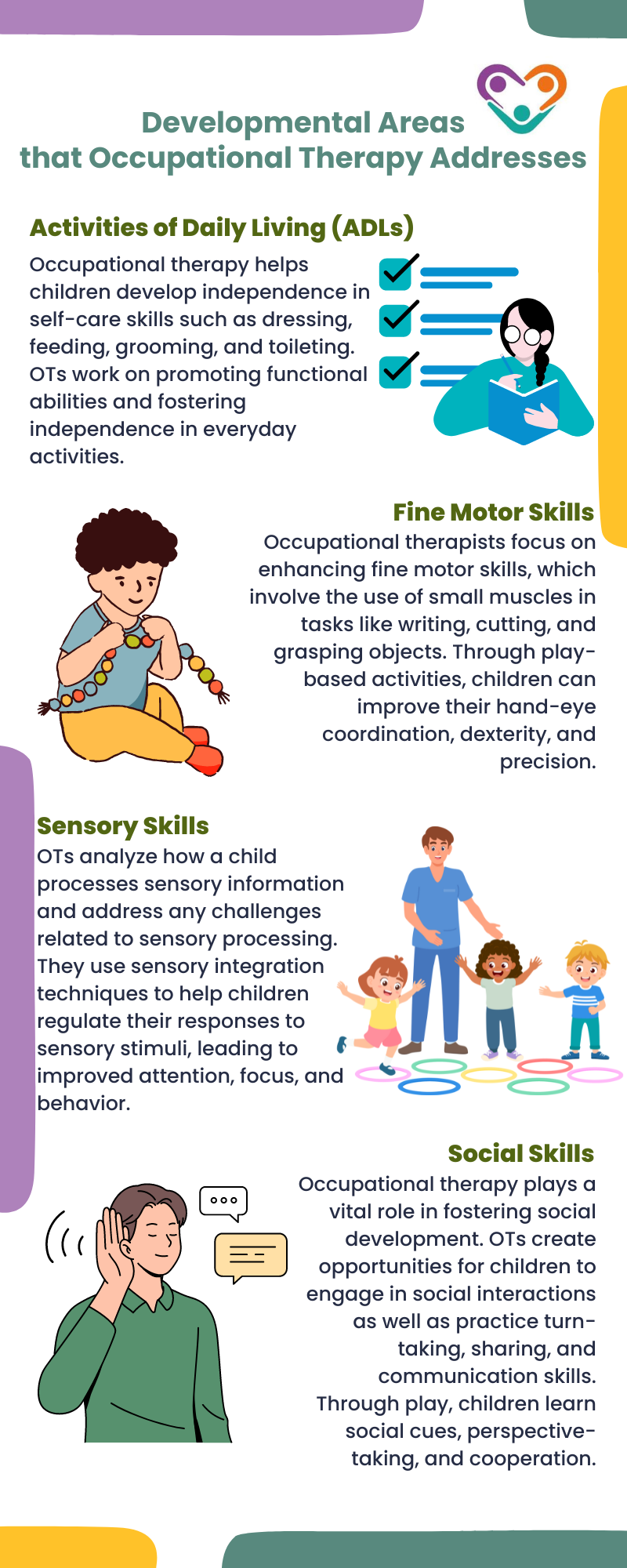
Table of Contents
Choosing between occupational therapy (OT) and applied behavior analysis (ABA) for your child can be overwhelming. Both aim to help children thrive, but they focus on different areas.
Occupational therapy helps kids develop skills for daily life activities like dressing, writing, and playing. On the other hand, ABA focuses on behavior modification, teaching new skills, and reducing unwanted behaviors. The decision depends on your child’s needs and goals.
Understanding the differences between OT and ABA can guide you in selecting the best fit for your child’s growth and development. Let’s explore which might be better suited for your child’s unique journey.
What is ABA Therapy?
ABA therapy places a strong emphasis on skill learning and development. ABA therapists work with children to improve their communication abilities, activities of daily living skills, and play skills.
By using techniques such as shaping and chaining, ABA therapists break down larger tasks into smaller, more manageable steps. This allows children to build upon their current skill level and gradually acquire new skills.
Tailoring therapy to the individual needs of each child allows ABA therapists to create targeted programs that focus on specific areas of skill development. These programs are designed to help children reach their full potential and enhance their overall functioning in various aspects of life.
In addition to skill development, behavior modification is another crucial aspect of ABA therapy. ABA therapists work with children to modify their behaviors and responses, helping them interact more effectively with their environment.
ABA therapy employs various behavioral techniques to address behavior modification. These techniques include positive reinforcement, where preferred behaviors are rewarded, and negative reinforcement, where undesired behaviors are discouraged. ABA therapists focus on implementing consistent and structured interventions to promote positive behavior changes in children.
What is Occupational Therapy?
Occupational therapy (OT) takes a distinct approach to addressing the needs of individuals with autism. Rather than solely focusing on behavior modification, OT emphasizes play-based skill improvement and targets a wide range of areas to support overall development.
Occupational therapists understand the power of play in facilitating skill development in children with autism. Through play, they create a therapeutic environment that encourages engagement, exploration, and learning. Play-based interventions allow children to practice and refine their skills in a natural and enjoyable setting.
By incorporating play into therapy sessions, occupational therapists can address various developmental areas, including:
Apart from these, occupational therapists assist children in developing emotional self-regulation and coping strategies. By engaging in play activities, children can explore and express their emotions in a safe and supportive environment.
Key Differences
When considering the choice between occupational therapy (OT) and Applied Behavior Analysis (ABA) therapy for a child, it’s essential to understand the key differences between these two approaches.
These differences are as follows:
Learning Approaches
A significant difference between OT and ABA therapy is their learning approaches. OT focuses on helping children learn new skills through play, creating a meaningful and engaging environment.
The goal is to support the child’s growth and participation in natural surroundings by addressing various areas such as self-care skills, fine motor skills, sensory processing, social skills, and emotional control.
On the other hand, ABA therapy primarily focuses on changing children’s behavior to learn new skills. It uses techniques such as shaping and chaining to reinforce desired behaviors and reduce challenging behaviors.
ABA therapy involves creating a plan with both short-term and long-term objectives that are adaptable based on the child’s needs. Progress is measured in achieving these goals.
Targeted Skills
Another distinguishing factor between OT and ABA therapy is the specific skills they target.
Occupational therapy aims to improve children’s independence in everyday living activities, addressing areas such as self-care skills (e.g., dressing, grooming, feeding), fine motor skills, gross motor skills, sensory processing, and social skills. OTs utilize various treatment methods to address these skills meaningfully through play, allowing children to develop and apply these skills in their daily lives.
In contrast, ABA therapy primarily focuses on developing socially useful behaviors for children with autism spectrum disorders. This includes communication and language abilities, social skills, and adaptive behaviors. The therapy involves creating a structured plan with specific objectives tailored to the child’s needs.
ABA therapists work closely with the child to reinforce positive behaviors and teach new skills, tracking progress along the way.
While both OT and ABA therapy have their unique approaches and targeted skills, it’s important to note that they can complement each other in providing comprehensive care for a child. Collaborative care, where OT and ABA therapy are integrated, can offer a holistic approach to address a wide range of needs and maximize the child’s development and well-being.
Reinforcement Strategies
ABA therapists use reinforcement strategies to encourage children to perform preferred behaviors that help them reach their goals. These strategies involve providing rewards or positive consequences for desired behaviors, which can motivate children to continue engaging in those behaviors.
Reinforcement can take various forms, such as verbal praise, tokens, or tangible rewards.
On the other hand, OT takes a different approach by focusing on self-motivation and using play as a means of reward. OT professionals encourage children to actively participate in activities and develop skills through engaging and enjoyable play-based interventions. The intrinsic motivation derived from the play itself serves as a reward for the child’s efforts.
Education Backgrounds
The education backgrounds of therapists in ABA and OT differ slightly, reflecting the unique focus of each discipline. OT professionals typically have more education in the medical field, equipping them with knowledge of anatomy, physiology, and other aspects of healthcare.
This background allows OTs to address various factors that can impact a child’s ability to engage in daily activities, including sensory integration, motor skills, and cognitive development.
ABA therapists, on the other hand, have more education in the psychology field. Their training emphasizes the principles of behavior analysis, including the understanding of behavior patterns, reinforcement strategies, and behavior modification techniques.
This expertise enables ABA therapists to observe and analyze behaviors, design behavior intervention plans, and facilitate positive behavior changes effectively.
Which is Better for Your Child?
When ABA therapists and OTs work together, they can incorporate strategies from both disciplines into their treatment sessions. ABA therapists excel in understanding and facilitating positive behavior changes, while OTs focus on sensory integration, motor functioning necessary for activities of daily living (ADLs), and academic skills.
By merging their respective approaches, they can create a more holistic and individualized treatment plan for clients.
But which one of them is actually better? Well, the answer is that it really depends on your child’s needs. If your child struggles with daily tasks like getting dressed or eating, OT might be the way to go. But if your child has trouble with behavior, especially if they have ASD, ABA could be a good fit.
The key is to talk to professionals and find out what’s best for your child. Sometimes, a combination of both OT and ABA can work wonders. Remember, every child is unique, and what works for one may not work for another. The important thing is to find the right support to help your child reach their full potential.
Sources:
https://www.abilityinnovations.com/blog/aba-therapy-vs-occupational-therapy
https://www.kiddy123.com/article/occupational-therapy-vs-aba-therapy-differences-how-to-choose.html
https://www.coremedicalgroup.com/blog/ot-and-applied-behavior-analysis-therapists-collaborative-care
- Autism Routine Disruption in Adults: Coping Tips - July 16, 2024
- Autism and Obsession: An Overview - July 16, 2024
- Autism and Taking Clothes Off: Management Tips - July 16, 2024




